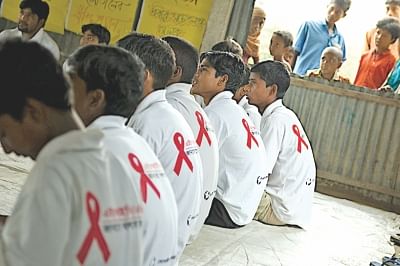Sexual and reproductive health information and services for adolescents
Sexual and reproductive health information and services for adolescents

A significant segment of the population aged 15-24 year constitutes about 19% of the total population, and a large cohort of adolescent and youth population will be entering their reproductive age in coming years. The age–sex structure of Bangladesh population pyramid constitute a wider share at its base than the top. This wider adolescent and youth segment of the population is considered as demographic dividend, and can create opportunity for social and economic growth through reduction of child marriage, maternal and infant mortality, increase contraceptive prevalence and reduce fertility.
But at present adolescent(15-19) fertility rate in Bangladesh is 118 per 1000 women, and this rate has not decreased expectedly for the last several decades. If we cannot further decrease fertility rate among this group of population, it will be really an ordeal and challenge to make significant progress in maternal health and family planning.
Despite the 18 year of legal age of marriage for girls, early marriage is prevalent in Bangladesh.
One survey done in 2013, indicates that Bangladesh has one of the highest rates of child marriage in the world. This survey shows that in Bangladesh, 64% of women currently aged 20–24 were married before the age of 18.
As a significant segment of population is entering into adult life every year, they need adequate, comprehensive and sustainable policy support and strategic direction to capitalize on them so that they develop life skill and acquire required information for sound sexual and reproductive health for at present and in near future.
In fact this group of population in Bangladesh are poorly informed about their sexual and reproductive rights, their rights for their active participation and meaningful engagement in planning and implementation of programs targeted for them. The knowledge and service available are often incomplete and inadequate for them.
Further, marriage at an early age is common in rural areas in Bangladesh where about 85 percent of the girls are married before they reach the age of 16. Prevailing cultural, social and economical factors viz. lack of safety and security for young girls, less economic value attached to girls and associated poverty are some of the important determinant factors for early marriage in Bangladesh. Further, once they are married they are under pressure to prove their fertility. Due to lack of social and economic empowerment, they bow down to the decisions of their husband, in-laws and other elderlies and jeopardize their reproductive health. This social phenomena ultimately resulted in early pregnancy, and risk of maternal morbidity and mortality.
In Bangladesh, violence and exploitation against adolescents girls are not uncommon and happens in many forms. Dowry related violence, martial rape, sexual harassment at work, trafficking and forced sex work, inflicting injury by acid through are prevalent in rural as well as in urban areas.
Further, sexual relationship among adolescents is not limited to marital bondage. In a survey on adolescents in Bangladesh, five percent respondents reported they had premarital/extramarital relationship. This group is at risk of unwanted pregnancy and sexually transmitted diseases including HIV.
In this context it is worthy to mention that only dissemination of information is not enough to change behavior of this group of population. Different studies also indicate that accessibility and availability of adequate information is not enough to change attitude and behavior. To change behavior, supporting and enabling environment at family, school and over and above with their peers are crucial and determining factors for responsible sexual behavior.
Adolescents often lack information in relation to sexual & reproductive health and life skills to say no to unsafe sex. Further, they do not have access to affordable and basic reproductive health related services. Many adolescents do not feel comfortable discussing sexuality issues with parents and elderly. This social phenomena create obstacle for access to information and comprehensive services for sound sexual and reproductive health, and continuing to be difficult challenge in Bangladesh. As mentioned, social and cultural barriers make it difficult to discuss issues related to reproductive health
In order to reach them effectively and successfully, innovative and creative approach such enter-education, peer education, leadership building for advocacy, and meaningful participation in planning and implementation of program targeted for them can also provide expected out come in the long run.
On the basis of these contexts and circumstances, we need a pragmatic adolescent and youth friendly policy to address and emphasize their reproductive health need, their voice to be heard and their potential to be explored for their meaningful engagement, participation and contribution in planning, implementation of interventions targeted for them.
Considering the social, economic and environmental factors in Bangladesh, adolescents who are marginalized, and excluded in planning, implementation and monitoring of activities should be targeted with due emphasis.
Further, community gate keepers like parents, teachers, local influential, religious and political leaders should be pragmatically involved in the total process of sexual and reproductive health intervention addressing adolescents.
Finally, unaddressed and unmet need of adolescents’ reproductive health in Bangladesh is considerable considering the geographical and population coverage. Due to lack of comprehensive ARH policy, accessible, available, affordable and sustainable adolescent friendly services so far is not been possible to meet the growing need of information and services for this group of population. Recently Ministry of Health and Family through Directorate of Family Planning, and financial and technical support of UNFPA has developed a National Plan of Action on Adolescent Reproductive Health. It is expected that this comprehensive document will address the “Demographic Dividend” issues as mentioned earlier and will contribute to a greater extent for a comprehensive and concerted effort on behalf of all level stakeholders to meet this unmet reproductive health need of adolescents in Bangladesh.
The writer is Technical Officer-ASRH and HIV, UNFPA.